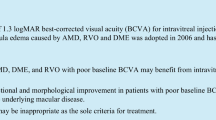Abstract
Purpose
To evaluate the efficacy and safety of intravitreal bevacizumab therapy for neovascular age-related macular degeneration (ARMD).
Methods
Patients with diagnosis of neovascular ARMD without any other ocular pathology were injected with 2.5 mg of intravitreal bevacizumab. A complete ophthalmic examination was undertaken in all patients, including best corrected visual acuity (BCVA), slit lamp biomicroscopy and ocular fundus examination. Ophthalmic follow-up evaluations included visual acuity measurements, optical coherence tomography (OCT) imaging, and fluorescein angiography at first, second and fourth week post injection.
Results
39 eyes of 39 patients were injected. The median age was 76 years-old (range 65–90), median visual acuity was 1.18 logMAR (range 0.18–3.00) and median retinal thickness was 388 microns (range 157–1237). By the fourth week of treatment, the median visual acuity was 0.88 (range 0.18–2.78) and median retinal thickness was 247 microns (range 108–1262). Statistically significant differences were found in visual acuity and retinal thickness before and after intravitreal injection (p=0.002, p<0.001, Wilcoxon rank test).
Conclusions
Our results suggest that intravitreal bevacizumab is well tolerated and is associated with improvement in BCVA and decreased mean retinal thickness by OCT. Further controlled and long term evaluation of intravitreal bevacizumab for the treatment of neovascular ARMD is warranted.



Similar content being viewed by others
References
Adamis AP, Shima DT (2005) The role of vascular endothelial growth factor in ocular health and disease. Retina 25:111–118
Gragoudas ES, Adamis AP, Cunningham ET Jr, Feinsod M, Guyer DR; VEGF Inhibition Study in Ocular Neovascularization Clinical Trial Group (2004) Pegaptanib for neovascular age-related macular degeneration. N Engl J Med 351:2805–2816
Gryziewicz L (2005) Regulatory aspects of drug approval for macular degeneration. Adv Drug Deliv Rev 57:2092–2098
Holekamp NM, Bouck N, Volpert O (2002) Pigment epithelium-derived factor is deficient in the vitreous of patients with choroidal neovascularisation due to age-related macular degeneration. Am J Ophthalmol 134:220–227
Hurwitz HI, Fehrenbacher L, Hainsworth JD, Heim W, Berlin J, Holmgren E, Hambleton J, Novotny WF, Kabbinavar F (2005) Bevacizumab in combination with fluorouracil and leucovorin: an active regimen for first-line metastatic colorectal cancer. J Clin Oncol 23:3502–3508
Macular Photocoagulation Study Group (1991) Argon laser photocoagulation for neovascular maculopathy. Five-year results from randomized clinical trials. Arch Ophthalmol 109:1109–1114
Michels S, Rosenfeld PJ (2005) Therapie der neovaskulären altersbedingten Makuladegeneration mit Ranibizumab/Lucentis. Klin Monatsbl Augenheilkd 222:480–484
Michels S, Rosenfeld PJ, Puliafito CA, Marcus EN, Venkatraman AS (2005) Systemic bevacizumab (Avastin) therapy for neovascular age-related macular degeneration twelve-week results of an uncontrolled open-label clinical study. Ophthalmology 112:1035–1047
Miller DW, Joussen AM, Holz FG (2003) Die molekularen Mechanismen der neovaskulären AMD. Ophthalmologe 100:92–96
Miller JW, Schmidt-Erfurth U, Sickenberg M, Pournaras CJ, Laqua H, Barbazetto I, Zografos L, Piguet B, Donati G, Lane AM, Birngruber R, van den Berg H, Strong A, Manjuris U, Gray T, Fsadni M, Bressler NM, Gragoudas ES (1999) Photodynamic therapy with verteporfin for choroidal neovascularisation caused by age-related macular degeneration: results of a single treatment in a phase 1 and 2 study. Arch Ophthalmol 117:1161–1173
Mordenti J, Cuthbertson RA, Ferrara N, Thomsen K, Berleau L, Licko V et al (1999) Comparisons of the intraocular tissue distribution, pharmacokinetics, and safety of 125I-labeled full-length and Fab antibodies in rhesus monkeys following intravitreal administration. Toxicol Pathol 27:536–544
Ng EW, Adamis AP (2005) Targeting angiogenesis, the underlying disorder in neovascular age-related macular degeneration. Can J Ophthalmol 40:352–368
Otani A, Takagi H, Oh H, Koyama S, Matsumura M, Honda Y (1999) Expressions of angiopoietins and Tie2 in human choroidal neovascular membranes. Invest Ophthalmol Vis Sci 40:1912–1920
Pauleikhoff D (2005) Neovascular age-related macular degeneration: Natural history and treatment outcomes. Retina 25:1065–1084
Rosenfeld PJ, Moshfeghi AA, Puliafito CA (2005) Optical coherence tomography findings after an intravitreal injection of bevacizumab (avastin) for neovascular age-related macular degeneration. Ophthalmic Surg Lasers Imaging 36:331–335
Rosenfeld PJ, Schwartz SD, Blumenkranz MS, Miller JW, Haller JA, Reimann JD, Greene WL, Shams N (2005) Maximum tolerated dose of a humanized anti-vascular endothelial growth factor antibody fragment for treating neovascular age-related macular degeneration. Ophthalmology 112:1048–1053
Schlingemann RO (2004) Role of growth factors and the wound healing response in age-related macular degeneration. Graefes Arch Clin Exp Ophthalmol 242:91–101
Shah MA, Ilson D, Kelsen DP (2005) Thromboembolic events in gastric cancer: high incidence in patients receiving irinotecan- and bevacizumab-based therapy. J Clin Oncol 23:2574–2576
Ta CN (2004) Minimizing the risk of endophthalmitis following intravitreous injections. Retina 24:699–705
Waheed NK, Miller JW (2004) Aptamers, intramers, and vascular endothelial growth factor. Int Ophthalmol Clin 44:11–22
Witmera AN, Vrensenb GF, Van Noorden CJF, Schlingemann RO (2003) Vascular endothelial growth factors and angiogenesis in eye diseases. Prog Retin Eye Res 22:1–29
Acknowledgements
Approved by the “Comité de Ética, Hospital Luis Sanchez Bulnes, Asociación para evitar la ceguera en México” comprising Jorge Villar Kuri, and Guillermo Salcedo-Casillas.
Author information
Authors and Affiliations
Corresponding author
Rights and permissions
About this article
Cite this article
Abrahám-Marin, M.L., Cortés-Luna, C.F., Álvarez-Rivera, G. et al. Intravitreal bevacizumab therapy for neovascular age-related macular degeneration: a pilot study. Graefe's Arch Clin Exp Ophthalmol 245, 651–655 (2007). https://doi.org/10.1007/s00417-006-0411-6
Received:
Revised:
Accepted:
Published:
Issue Date:
DOI: https://doi.org/10.1007/s00417-006-0411-6




